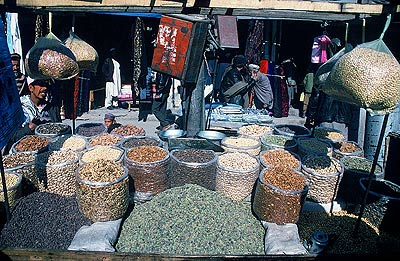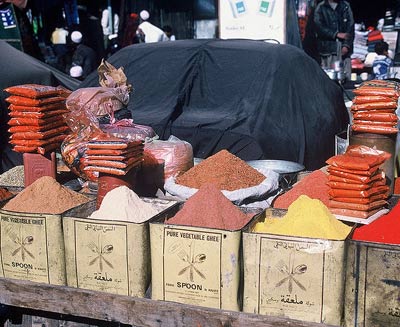What is strikingly similar today to the Kabul of old is the setup of the local bazaar and the
 |
| A bakery in Kabul. Photo by Steve Evans |
manner in which produce is sold. For those of us lucky enough to cook our own meals, shopping usually entails a trip to the local vegetable market to see what is in season, followed by a stop at the local naan shop for either freshly baked flat bread (which, in Afghanistan, is very good) or a bag of dough to use as pizza or bread base in home-made recipes. Since language always remains an issue, you quickly learn the important Dari terms for some of your favorites, such as the ever-present gasneetch (cilantro) in our house.
Following long-established tradition, it is still customary to employ a chowkidor (one who sits). This is usually a young man who is in charge of manning the gate, filling the gas bottles, keeping the stoves burning in the winter, running errands, and shopping. Some things never translated to an Afghan, including avocados and mushrooms, though our driver once excitedly drove his food-crazed employers to a cart selling the “vegetable that taste like meat,”—mushrooms. During a two-week period in 2008, we found large white Asian mushrooms for sale on local carts around Kabul. Slowly, as our obsession with food and our Kabul kitchen grew, our home also became a haven for anyone in need of a home-cooked meal.
 |
 |
| Market stalls in Kabul. Photos by USAID. |
Fortunately for all foodies in Kabul today, the city has seen an enormous increase in the variety of available food products (both fresh and otherwise) in the past three years. Whereas in 2007, we were limited to a few grimy markets that sold a smattering of dusty, expired tins of food and random condiments that we used to joke must have “fallen off a supply truck” (how else to explain blood pudding and canned cranberry sauce in an Afghan convenience store?), Kabul today boasts a growing array of “Western-style” supermarkets. These heavily-guarded institutions stock everything from Pantene shampoo to Nando’s Peri-Peri Sauce (to the South Africans’ delight).
While these markets have reasonably good selection of fresh vegetables, the best place for veggies remains, ironically, Butcher Street. Here, seeing a dead cow displayed in the trunk of a taxi is the norm on any early morning, but the best fresh produce is also laid out daily. For about $10 you can get an enormous bag of your favorite root vegetables, delicious tomatoes, some lettuce, and a good selection of fruit. Herbs (apart from cilantro and parsley) are few and far between.
To augment our fresh purchases, we cultivated our first-ever vegetable garden in Kabul. Thanks to the spring and summer climate we were able to grow an abundance of cherry and grape tomatoes in red, yellow and orange, arugula, three kinds of lettuce, radishes, celery, parsley, dill and even one melon. The salads in particular were a treat, and sustained us and our heavy hosting schedule for an entire summer and fall in 2009. With these and other favorites like good olive oils, vinegars, kitchen knives, pot hangers and grains smuggled in from occasional R&R trips abroad, we managed to carve out quite the foodie sanctuary—not only for ourselves, but for our friends and colleagues.





